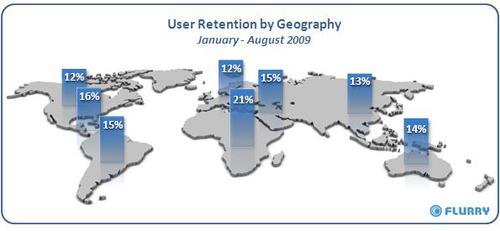In this analysis, Flurry looks at user retention by international territory. As the App Store expands internationally, studying differences between user behavior across territories is becoming more important. Increasingly, app developers are faced with international market expansion decisions, and need to consider the cost of localizing and promoting an app in a new territory against the value of capturing those new users. While any developer using Flurry Analytics can track usage by country for their own applications, we wanted to share a global snapshot of data we’ve collected from more than 200 countries to provide some helpful context.
Taking a cut of data by location from January through August of this year, we build out the map graphic below. The total data set contains data from approxately one billion tracked user session, ranging between millions to hundreds of millions per geographic territory represented. Flurry measures user retention by the number of users who downloaded an application, at any time in the past, and used that app within the last seven days. The global average for user retention is 14.8%.

Before our analysis, we expected to see users in developing economies, which have less wire-line infrastructure and use phones more as PC-substitutes, show higher app retention rates. This hypothesis held true. Regions that can be characterized as developing economies have above average retention rates: Africa (21%), Central America (16%), the Middle East (15%) and South America (15%). Whereas more developed economies show lower-than-average retention rates: North America (12%), Europe (12%), Asia (13%) and Australia (14%). It’s worth noting that our sample for Asia is made up primarily by more advanced economies including Japan, Hong Kong, Singapore and Russia.
In particular, we find that North America and Europe have the lowest retention rates. Because these two markets represent iPhone’s home-base, which comprises a large part of our sample, we reason that the sheer number of available apps in the App Store generates more churn as consumers are presented with increasingly more choices. We first discussed the relationship between consumer choice and retention in Flurry’s June Pulse Report, where we compared iPhone vs. Android retention and found that Android users demonstrate higher app loyalty, but also have far fewer choices in the Android Market compared to that of the App Store. Finally, we believe that higher disposable income levels in developed economies allow consumers to try and abandon (paid) apps more feely.